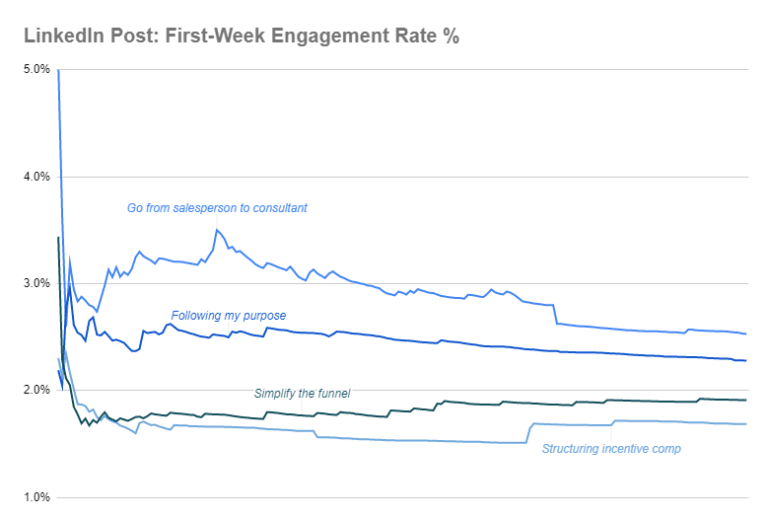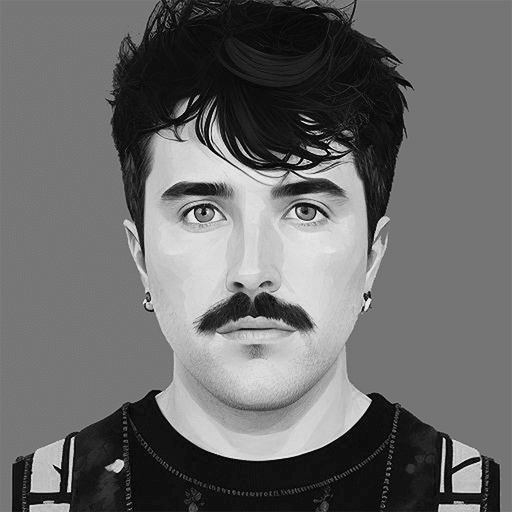It’s time to admit it. The LinkedIn profile has replaced the resumé, and for good reason.
With the combination of imagery, a Headline, full Bio and rich experience sections, and most importantly, regular Post content: this is the starting point to any professional endeavor.
So, whether your goal is to find bigger and better roles, generate high-quality consulting or SaaS leads, or even just reflect the best impression possible to people who are already coming to your page, make sure you’re putting your best foot forward.
I’m qualified to talk to you about this because I’ve been doing it myself for years, and my profile has been the landing page for my digital reputation. Here’s a chart showing the revenue I’ve pulled in over the course of 4 ½ years with my personal LinkedIn presence alone: $1.7M.
Having seen success ourselves from LinkedIn profile optimization, I’ll explain how to actually get results from it yourself. If you’re looking for a social selling workshop, look no further .. we’ve got you covered.
Who benefits from a fully optimized profile?
- Ambitious professionals who want to increase their earnings. You’re far more likely to be found and seen as credible by headhunters and recruiters if your profile speaks volumes about your skills, experience, and knowledge. Your title alone is cheap: it doesn’t add context. But if your profile tells a compelling story about your career, goals, and mission: now you’re cooking with gas! People are going to want to talk to you and share opportunities with you.
- Anyone in a sales or business development role. It’s obvious: whether you get the notification or not, people you’re selling to are looking at your LinkedIn profile. You would, too: someone’s email signature might have their title in it, but you want to see their face and the rest of their experience to know if it’s worth spending time with them in a sales process. Make sure you’re not losing ground, and – preferably – gaining ground, via a strong profile.
- High-growth company executives. Your company’s brand is the sum of the brands of its people: as a founder or executive, you’re one of the most important parts of that. If you’re not using your profile to network for recruiting, reflect well on your company, and generate strategic sales and partnership opportunities, then you’re leaving money on the table.
- Freelancers, consultants, & knowledge service providers. As a service provider, you need people to first trust you, then like you, then find you credible. Then, they’ll want to hire your services. If you’re thinking of working with an accountant, each with exactly the same credentials, proposal, and rates – but one has an appealing profile with regular, interesting updates on tax strategies – you’re going with that one. Why leave it to chance and let your competitors out-sell you? Be the consultant that charges $1000/hr (seriously), not the one offering a 10% discount off your $145/hr rate.
How To Improve Your LinkedIn Profile
1. Headshot
What do these photos have in common?
(That’s me, in the middle ☝🏼)
They’re all professional headshots, intended for this purpose, cropped from the shoulders up. Their faces are clear, they’re smiling, and the background is uncomplicated. All of these people have made a significant amount of revenue from their LinkedIn presences.
Don’t leave your profile picture blank. Avoid photos where you’re wearing something distracting, or using a cropped photo from hanging out with your friends. Finally, don’t let your face be too hard to see from the thumbnail:
2. Headline
The headline is different from your job title: or, at least it should be. This is where the headline appears around LinkedIn:
(First thing under their name when you view their profile)
(Below their name when you see their posts)
You don’t, however, see someone’s job title or description in many places. To see that, you have to scroll down on someone’s profile until you get to the Experience section.
Because the Headline is featured more prominently and more often, it’s more important than your job title.
The following headlines are helpful and compelling, and they’re more creative than just the job title:
- I help startups hire sales leaders without the cringe ⋆ Personally closed $100MM+ (and counting) ⋆ Founder/CEO ⋆ 2 Exits ⋆ 3X Entrepreneur ⋆ Strategic Advisor ⋆ LinkedIn Top Sales Voice 2020 ⋆ Thursday Night Sales
- Co-founder at Lavender. Write better sales emails faster with our in-inbox coach. Get started for Free at Install.TryLavender.com
- 80% of customers dump you after 1-2 bad digital customer experiences. I protect you from that. Let’s chat!
You don’t need to have a headline a mile long. Consider including your title if you’re a senior decision maker, but you also don’t have to.
Knowing the most compelling benefit you have to offer your network is beyond the scope of this article, but your headline is where you want to list it: maybe that’s your wealth of experience, or the most interesting thing your product does, or the results you get for your clients.
Go beyond your job title.
3. “About” section
Think of this as your personal landing page. Your job is to make your ideal client/employer feel that they’re in the right place when they read it. It’s different from a “brand” landing page, since it’s yours. And your current role is only one chapter in your story, even if you’re the founder.
This is your chance to show what interests you, and how your interests mesh with why you’re working on what you’re passionate about. Bonus points if you work in some results you’ve achieved for past employers/clients.
Samantha McKenna shows a fantastic example of how to write an About section, here (abridged):
It makes you want to keep reading. Write, and rewrite, yours until you have that effect on your profile visitors.
4. Content & Featured Posts
You don’t have to be an innovative visionary thought leader futurist – blegh! – to post on LinkedIn.
All you have to do is share your knowledge, casually and informally, like you would talk about it to a friend.
I have a structure of a Post that works well. First, use a “hook” – but it doesn’t have to sound like clickbait. Just think to yourself, If I didn’t know me, what might make me stop scrolling and want to learn more about what I’m about to say?
Then, in as simple language as possible, share the How To, Tip, Workflow, Celebration, Award, or whatever else it is that you want to talk about.
Finally, close with 1-3 lines about what this means to you, how it’s impacted you and those around you, and consider adding a few of the automatically-suggested LinkedIn hashtags.
When you’ve done this a few times, go to the Three Dots icon at the top-right of your post, once it’s published, and Feature it. It’ll show up here:
Play with how your featured posts look until you like it. Every so often, feel free to swap out your older Featured posts for new ones, to stay current and relevant.
5. Network & Community
The single biggest factor influencing your impact on LinkedIn is one that you can’t easily tell visually: who knows you and values your experience. Ideally, as many people as possible who are decision-makers and find you credible or have worked with you before, are connected to you on LinkedIn.
When you’re done, use software like our product Aware, to keep track of when these connections are active on LinkedIn, so you don’t waste the opportunity.
Keep in mind when making a Connection with someone that it’s not just them you’ll be connected to, but their connections, as well. This is called a 2nd-Degree Connection. For example, if the CPA Firm that works with hundreds of my dream clients is in my network, and they engage with my content, I don’t need to be connected to my dream clients for them to see my posts.
Lastly, I can’t emphasize enough how important it is to treat your network as a valued community. You cannot simply connect and forget people, and expect them to support you. If your content is good enough, that will happen anyway: but you should not value connecting with people purely in order to have them see your content, or sell to them.
Here are some things you can do, that cost you nothing, that help you build relationships:
- Offer free advice or super-light consulting
- Make intros between your connections and potential clients for them
- Trade stories with someone in a way that helps them solve a problem
- Engage with their content in a valuable way, so that your connections end up engaging with them too
Listen actively to people to understand what they’re looking for. Then, try to give that to them. Don’t bend over backwards to help people who only want to leech off you, but that is rare – and if it happens, set a boundary with that person.
6. Job Description
Don’t overthink this: tell a story about what you did at your job, what you accomplished, and what your impact was. However, avoid using both jargon and overly-bland language. Here’s an example of the same job description, written in two ways:
BORING:
- Territory Sales Manager
- Drove sales through collaboration and communication across multiple departments to help hit sales goals. Reported results on a monthly basis to upper management and successfully grew territory.
BETTER:
- Sales Manager, East Coast
- Obsessively hired the best people, resulting in 7/8 reps hitting quota within their first three quarters. Spent ⅓ of my time coaching, listened to calls every day to provide feedback to my reps, who appreciated the disciplined approach to growing their skills. This work resulted in a 70% growth in my territory’s total sales, during my tenure. I’ll never forget the great, tight-knit team we built.
See how the same job can sound like an absolute drag, or tons of fun and lively? The latter does a much better job of communicating your skills and qualities to someone who doesn’t know you yet.
7. Banner Image
Creating a banner image is as simple as taking your company brand guidelines to a designer, adding badges/awards you’ve won, other certifications, or even the logos of impressive companies you’ve worked at (if you’re sure you have the rights to use these images!).
Alternatively, just upload a picture of you doing what you love, with your family, or a place that you spend a lot of time in. It could be skiing with your kids, a shot of Yosemite, or anything else you love.
If you shop this work to a designer, expect to pay $50-200. It’s worth the investment. And if you don’t, try to pick an image that communicates something about you. Avoid clipart, low-resolution images, unprofessional photography, or just leaving this section blank.
Here are a some excellent banner images of all varieties:
Avoid these kinds of images:
- Plain text on white background with an outdated company logo
- This phrase is full of jargon, and doesn’t tell people what you do
- The default background image
8. Endorsements
Endorse others whose skills you are confident in, and they’ll be much more likely to endorse you in return. Make sure that the skills you want to highlight, are highlighted: if you excel at revenue operations, avoid featuring your Microsoft Office skills; instead, add a new and interesting skill like “Troops.ai” or “Syncari”, as well as “Salesforce Reporting” and the other main parts of your job.
It’s okay to ask people you’ve worked with for endorsements, as long as you aren’t implying that they should endorse you for skills you don’t actually have.
Examples of the best linkedin profiles out there for your inspiration
Ken Marshall – Chief Growth Officer at RevenueZen
What he does well:
- On-brand colors in the background image match the logo, and the text assures his readers that he’s a quantitative revenue strategist: if you’re looking for a hard-numbers person, you know that Ken will have that conversation with you.
- The first few lines of his About section make it clear what kind of problems he helps solve. If you’re not seeing results from your marketing, you’ll keep reading.
Where he can improve:
- With ~1400 followers as of this writing, Ken would benefit from more time spent connecting with new people and networking with influencers and decision-makers.
Alex Franco – AE Team Lead at Chili Piper
What he does well:
- Orange circle around his background image is aligned with his coworkers’ color scheme; the background image makes it clear he works in SaaS demand generation technology
- In the About section, the Chili Piper emoticons are unmistakable! His experience clearly goes beyond sales, and he highlights that. This tells his prospects he’s more interesting than just someone who closes deals all day and nothing else.
Where he can improve:
- Profiles should be written in the first person, not the third person, for a personal-level impact, rather than giving people the impression that they’re reading a ‘job resume’.
Samantha McKenna, Founder of #samsales
What she does well:
- Sam’s profile screams success and professionalism, but also warmth: there’s emotion in all of her face imagery.
- Her background image and About section tell a strong story that reinforce her credibility as a sales expert and founder.
Where she could improve:
- Sam writes highly-engaging content – if she Featured one fewer video, and instead featured one of her best-performing Text posts on her Featured section, it might make it even clearer right from the get-go that she’s someone who has significant experience, authority, and trust in the industry.
Build It Up Over Time
You don’t need to have your profile perfect on Day 1, to start growing your network.
Instead, focus on being consistent at the following things:
- Connecting with new people on LinkedIn
- Having offline networking conversations, at least a few times per month
- Catching up with old coworkers
- Writing posts about experiences you’ve undergone, lessons you’ve learned, and accomplishments you’ve had lately
Over time, your presence on LinkedIn WILL grow if you spend the time to do these things, and you bring care and curiosity to your work.
What better time than now to take a look at your current profile with fresh eyes, sprucing it up with some new content, and making an impact on your goals for the next few quarters?
P.S. If you’re reading this and wondering how we can help build your company’s brand on LinkedIn, contact us and we’ll show you how to use network building and content creation, at scale, to bring massive brand awareness to your company.













